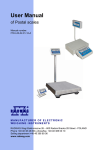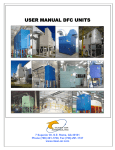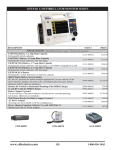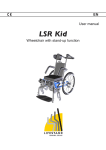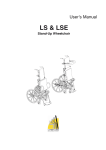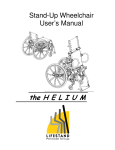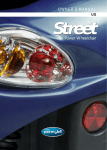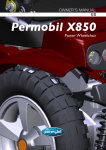Download USER MANUAL - Algol
Transcript
USER MANUAL UK User manual LSR Wheelchair with stand-up function Where to find Permobil Permobil Europe BV is responsible for the servicing and sales carried out by its importers and local dealers throughout large parts of Europe. So contact us if you have any questions regarding servicing or sales in the area where you live. Permobil Europe BV De Doom 22 NL-6419 CX Heerlen Netherlands Tel: +31 (0)45 564 54 90 Fax: +31 (0) 45 564 54 91 Email: [email protected] The Permobil Group’s Head Office Permobil AB Box 120 861 23 Timrå Sweden Tel: +46 60 59 59 00 Fax: +46 60 57 52 50 E-mail:[email protected] LSR Wheelchair with stand-up function Produced and published by Permobil AB, Sweden Version: 1, 2011-01 Art. no.: 205259-US-0 User Manual LSR Contents Important information....................................................................................................................... 6 General information.......................................................................................................................... 7 Technical support..................................................................................................................... 7 Spare parts & accessories........................................................................................................ 7 Disposal.................................................................................................................................... 7 Warranty & servicing................................................................................................................ 7 Product approval....................................................................................................................... 7 Safety rules and regulations.................................................................................................... 8-15 Design & function........................................................................................................................... 16 General - overview................................................................................................................. 16 Raising function...................................................................................................................... 17 Control panel for raising function........................................................................................... 18 Operation........................................................................................................................................ 19 General .................................................................................................................................. 19 Raising function...................................................................................................................... 20 Adjustment..................................................................................................................................... 24 Foot and leg rest ................................................................................................................... 24 Knee supports ...................................................................................................................... 25 Seat depth ............................................................................................................................ 26 Center of gravity ................................................................................................................... 27 Back rest height . .................................................................................................................. 28 Back rest angle . ................................................................................................................... 29 Equalization system . ............................................................................................................ 30 Anti-tip protection . ................................................................................................................ 32 Brakes .................................................................................................................................. 33 Transport........................................................................................................................................ 34 Wheels.................................................................................................................................... 34 Back rest................................................................................................................................. 34 Maintenance and repairs................................................................................................................ 36 General................................................................................................................................... 36 Batteries, storage.................................................................................................................... 37 Charging batteries.................................................................................................................. 38 Cleaning.................................................................................................................................. 39 Wheels.................................................................................................................................... 40 Technical specifications................................................................................................................. 42 5 Important information User Manual LSR Important information about the user manual Congratulations on choosing a LifeStand stand-up wheelchair. Our aim is your continued satisfaction with your choice of supplier and wheelchair. Before you start using your wheelchair, it is important to read and understand this user manual and in particular the section on Safety. The user manual is primarily intended to inform you about the functions and capabilities of your wheelchair and to advise you on the best way of using it. It also contains important safety and maintenance information and describes some of the problems which might arise when you drive the wheelchair. Always keep the user manual on or near your wheelchair, as you may need to consult it for essential information on use, safety and maintenance. You can also find information on our products on our website. You will find us at www.permobil.com. All information and all photographs, illustrations and specifications are based on the product information that was available at the time this user manual was printed. Pictures and illustrations that appear in the user manual are typical examples and are not intended to be exact depictions of different parts of the wheelchair. We reserve the right to make changes to the product without prior notification. Ordering of Documentation If you are in need of another copy of the Owner’s Manual, it can be ordered from Permobil. Benefits of a Daily Standing Regimen The use of any stand-up device should be done only under the prescription and supervision of a medical professional. At the outset, it is recommended that your introduction to regular standing be closely monitored by your Physical or Occupational Therapist. It has been documented that the regular and cyclical activity of going from the seated to the standing position may offer many benefits to those that are no longer able to stand on their own. The benefits are two fold: 1) there is the ability to once again function in daily activities that necessitate standing (reaching file cabinets and equipment in the workplace, accessing cupboards/stoves/shelving at home, as well as the ability to interact eye to eye); and, 2) the potential of physical benefits that result from repeated standing (these benefits may include improved; range of motion, bone density, circulation, bowel and bladder function, etc.). 6 User Manual LSR Technical support, warranty, etc. TECHNICAL SUPPORT In the event of technical problems, you should contact your dealer or Permobil Inc USA at 1-800-736-0925. Always state the chassis serial number when contacting Permobil to ensure that the correct information is provided. SPARE PARTS & ACCESSORIES Spare parts and accessories must be ordered through your dealer. WARRANTY A warranty registration card is attached to each new wheelchair. The Permobil Inc. Product Warranty Information sets forth the conditions of the warranty. Contact your dealer or Permobil Inc USA for information about the warranty period for this wheelchair. 7 User Manual LSR Safety rules and regulations Safety rules and regulations A stand-up wheelchair is a complicated product. Therefore, you need to be very careful when you use and handle it. It is important to read and follow the instructions and safety rules given in this user manual before starting to use your wheelchair, as incorrect use could lead to injury to the user or damage to the wheelchair. Warning labels The user manual contains the following "warning labels" which are intended to draw attention to situations which could lead to problems, near-accidents, personal injury or damage to the wheelchair, etc. m CAUTION! Take care here. m WARNING! Take extra care here. Risk of personal injury or damage to the wheelchair and its surroundings. Permobil accepts no liability for personal injury or damage to property which may arise from the failure of the user or other persons to follow the recommendations, warnings and instructions given in this user manual. 8 User Manual LSR Safety rules and regulations Safety rules and regulations Your wheelchair may have been adjusted precisely to your needs on delivery, so you should always ask the advice of the person who provided the seat for you before making changes or adjustments to the wheelchair. Certain adjustments may impair the wheelchair's safety/functions or its suitability for your needs. It is also extremely important to take the necessary time to familiarize yourself with the raising function of the wheelchair before you start using it. Do not make your first attempt to stand up on your own. Make sure you have assistance close by if you should need help. To ensure that the seat has not been damaged during transport to you, please check the following before initial use: • Check that all products ordered are included in the delivery. If you suspect that something is missing, contact your mobility aids center or Permobil as soon as possible for further information. • Check that no transport damage or other damage has occurred to the seat or its accessories. If you discover any damage or notice any other problem, contact your mobility aids center or Permobil as soon as possible for further information before continuing your inspection. Also check that the air pressure in the wheelchair tires is correct before you start using the wheelchair. If, in any situation, you find that the wheelchair does not behave as expected or you suspect that something is wrong, contact your service contact or Permobil for information. 9 User Manual LSR Safety rules and regulations Safety rules and regulations m CAUTION! Operation Do not allow children to drive the wheelchair unsupervised. Do not use the wheelchair on public streets and roads. Follow local regulations for pedestrians and remember that vehicle drivers may find it difficult to see you. Do not drive the wheelchair if you are under the influence of alcohol. Alcohol may affect your ability to use the wheelchair safely. Some physical limitations or the ingestion of medicines, either prescription or over the counter medicines, may limit your ability to use the wheelchair safely. Always consult your physician about your limitations and medicines. m WARNING! Maintenance and service Carry out only the servicing and maintenance activities indicated in this user manual. All other servicing, changes and interventions in the wheelchair should be carried out by a qualified service engineer or a person with adequate knowledge to undertake this in an expert manner. In case of doubt, always contact a qualified service engineer or Permobil. Weight limits The maximum user weight for your wheelchair is specified in the specifications section of this user manual. If the wheelchair is used by anyone who weighs more than the maximum permitted user weight, the result may be personal injury or damage to property, including damage to the wheelchair. This may also invalidate the wheelchair's warranty. Do not carry passengers on the wheelchair. This can lead to personal injury and damage to the wheelchair. 10 User Manual LSR Safety rules and regulations Safety rules and regulations m WARNING! Driving on sloping surfaces When you drive up a slope, ensure that you drive the wheelchair straight up the slope (vertically). If you drive at an angle, there is an increased risk of tipping over or falling. Be extremely careful when you drive up a slope. Always avoid driving on slopes covered with snow, ice, gravel, clay, sand, wet leaves or similar, or where the surface is uneven. m WARNING! Operation - turning/cornering The risk of the wheelchair tipping over increases at high turning speed, in tight curves, on uneven surfaces, with fast changes of direction and if you drive from a place with low friction (for example a lawn) to a place with high friction (for example a gravel road). To avoid tipping over, with the risk of personal injury or damage to property that entails, you should always drive slowly when turning/cornering and changing direction. Driving on steps and stairs Wherever you come across obstacles, you should always approach them slowly, preferably in the company of another person watching or helping you. The front wheels can be raised from the ground by your carer by treading on the anti-tip protection on the rear of the chair and pulling back and down on the carer handle at the same time. Although it is not recommended for the chair to be tipped back any further (the anti-tip protection will touch the floor), it is possible. This is done by turning the anti-tip protection to the upper position (see page 32). Make sure to put the anti-tip protection into operational mode again once the procedure is complete. Driving on inclines When moving uphill, always lean forwards and avoid changing direction suddenly. When moving downhill, always lean backwards. It is also important to keep speed and direction under control. Make sure that the wheelchair is facing up or down the hill. Never try to drive diagonally or swing down a slope. 11 User Manual LSR Safety rules and regulations Safety rules and regulations m WARNING! Passengers The wheelchair is not designed to transport passengers, whatever their age. Nor is it designed for taking heavy items other than the user's personal belongings. The maximum user weight specified in the user manual for the seat in question must not be exceeded. Ignoring this could impair the wheelchair's maneuverability and stability. Operation in different climates Avoid exposing the wheelchair to very low temperatures, prolonged moisture, heavy rain/snowfall and similar situations. Do not use the wheelchair when it is icy or slippery outdoors. These conditions may impair the performance and safety of the wheelchair, which could result in accident, personal injury and damage to property, including damage to the wheelchair. 12 User Manual LSR Safety rules and regulations Safety rules and regulations m WARNING! Seat belt The seat belt is only designed to hold the user in place and not as protection in the case of collision/accident. Check the condition of the belts regularly in case any damage or worn places have developed. Getting in and out of the chair Make sure the wheelchair brakes are activated before getting into or out of the wheelchair. When getting into or out of the wheelchair, you should take all precautions to reduce the distance between the wheelchair and the point to which the user is moving. If this distance is increased, it could result in the user losing balance or falling over. We recommend that users get in and out with another person present to keep an eye on the operation or to help. Be careful when bending down or reaching out to get something. Do not use the foot plates or arm rests as supports when getting into or out of the wheelchair. The foot plates and arm rests are not intended to support heavy loads. Unnecessarily high load could cause them to give way, which could result in personal injury or damage to property, including damage to the wheelchair. 13 User Manual LSR Safety rules and regulations Safety rules and regulations m WARNING! Transport The wheelchair must only be transported in vehicles approved for this purpose. Carefully check that the wheelchair is properly secured. An inadequately secured wheelchair could cause major damage and injury if it broke loose, both to persons in the transport vehicle and to the vehicle and the wheelchair itself. Use in motor vehicles forbidden We recommend that users are NOT transported in any vehicle while seated in the wheelchair. The only safe option is for the user to move to a seat in the vehicle and to use the vehicle's seat belt system. Do not sit in the wheelchair in a moving vehicle. In the event of an accident or a sudden stop, the user could be thrown from the chair, resulting in serious injuries. The seat belt is solely designed to hold the user in place and offers no protection in the event of an accident. 14 User Manual LSR Safety rules and regulations Safety rules and regulations m WARNING! Maintenance and service Carry out only the servicing and maintenance activities indicated in this user manual. All other service, alterations and changes to the wheelchair and the vital systems of its accessories must be carried out by a competent service engineer or a person suitably qualified to do so in an expert manner. In case of doubt, always contact a qualified service engineer or Permobil. Use only spare parts or accessories approved or recommended by Permobil. All other use could lead to changes which might impair the functions and safety of the wheelchair. It could also lead to the warranty for your wheelchair becoming invalid. Damage to/breakdowns in the wheelchair and its accessories If at any point you notice that the wheelchair and its various functions are not behaving as expected or if you suspect something is wrong, stop using your wheelchair as soon as possible, turn off the wheelchair and contact your mobility aids center or Permobil for information. It is extremely important that Permobil is informed if the wheelchair or its accessories have been damaged during transport, during driving or for any other reason as soon as possible after the damage has occurred. There could be a risk that the wheelchair and its accessories can no longer be operated safely and without danger. 15 User Manual LSR Design and function Design & function General LSR is a manual wheelchair for outdoor and indoor use. It is intended for people with physical disabilities. Its raising function allows the user greater freedom of movement. We recommend gradual training in standing up under the guidance of a physiotherapist before you use "LSR" every day. You will gain the greatest benefit in standing up if you regularly switch between a sitting and a standing position. This alternation is simple with the LSR wheelchair. The wheelchair is aquipped with armrests, fotplates, anti-tip protection and battery charger. Overview 5 1 6 2 7 3 4 8 1. 2. 3. 4. 5. 6. 7. 8. Arm rest Knee supports Leg rest Foot plate 16 Push handle Back rest Rear wheels Front wheels User Manual LSR Design and function Design & function Raising function The electric raising function makes it possible for the user to stand up in their wheelchair. This function is accessed from a control panel located on one arm rest. Stand-up function 17 User Manual LSR Design and function Design & function Control panel for raising function The control panel has two buttons to control the seat's raising function. The control panel is secured by means of Velcro and can be fitted to either arm rest in the position that best suits the user. There is a socket at the front of the control panel for connecting the accompanying battery charger. Function keys 18 User Manual LSR Operation Operation General LSR is designed for use both indoors and outdoors. For use indoors, attention must be paid when driving in narrow corridors, when passing through doors and entrances and when traveling on elevators and ramps, etc. Remember that there is a risk of crushing when using the electrical raising function. Outdoors you must remember to travel very slowly on steep downhill slopes and take great care on uneven surfaces, uphill slopes and sideways gradients. Always observe a good safe distance when driving near edges and precipices. We recommend that you practice in an environment in which you feel safe so that you are very familiar with how the wheelchair and its accessories behave in different situations before you start to use the wheelchair in public locations. Armrests The armrests can be folded backwards to facilitate when getting in and out of the chair. See fig. below. 19 User Manual LSR Operation Operation Raising function General The wheelchair seat is operated via its control panel. The control panel has two buttons. Before using the raising function, it is extremely important that all the seat's settings are adapted to the current user. More detailed information on adjustments can be found on pages 24-33. Left button (Arrow forward) This button is used to operate the raising function from sitting to standing position, or to move from reclined to sitting position. Right button (Arrow backward) This button is used to move from standing to sitting position, or to move from sitting to a slightly reclined position. Control panel for raising function m WARNING! Use the raising function with great care and be aware of the danger of crushing. Using the control panel, the position of the seat can be changed between reclined, normal sitting and standing position. 20 User Manual LSR Operation Operation Raising function m WARNING! Make sure that the wheelchair is on a flat, horizontal surface, free of obstacles or ground depressions. Make sure the brakes are activated! If this is not the case, the wheelchair may roll away, with the risk of personal injury. Make sure that the knee supports are correctly secured. See page 22. Make sure that the arm rest is correctly secured in the raising position. See page 23. Raising Press the right or left button, depending on whether the seat is to be raised to the standing position or lowered to the normal or reclined position. To stop the system, release the button. You can stop at any intermediate position. Once the system has reached its end point, it will stop automatically. m CAUTION! Stress on the muscles may be relieved by taking regular rest periods. Make sure that the coiled cable never wraps around the arm rest, either in the position for the arm rest or the chest support, as it may be damaged when the arm rest swings round. If the cable is damaged due to being cut or squeezed, this is not covered by the warranty. 21 User Manual LSR Operation Operation Raising function Knee supports Before raising may commence, the knee supports must be secured in the right position. The knee supports place pressure on the upper section of the shin when the wheelchair mechanisms work together to raise the body to the standing position. Securing the knee supports In order to secure the knee supports, turn each of them inwards so that they dock. The left knee support must be put in place first so that the right knee support can be secured in the knee support's locking mechanism. Release the knee supports In order to release the knee support, press the red button on the locking mechanism and turn the knee support outwards. m CAUTION! The knee supports may only be released in sitting position Knee supports in unfolded position. Knee supports secured in position for raising. 22 User Manual LSR Operation Operation Raising function Arm rest Before raising may commence, the arm rests must be secured in the right position. The arm rests then provide support for the upper body during the raising process and in the standing position. Secure the arm rests in the raising position Lift the arm rests and turn them inwards at the same time. With the outer angled section of the arm rests in the horizontal position, lower the arm rests again so that they are secured in the raising position. Arm rests in normal position. Arm rests in raising position. m CAUTION! Make sure that the coiled cable never wraps around the arm rest, either in the position for the arm rest or the chest support, as it may be damaged when the arm rest swings round. If the cable is damaged due to being cut or squeezed, this is not covered by the warranty. 23 User Manual LSR Adjustment Adjustment Foot and leg rest For the best sitting comfort and to achieve the correct position for standing up, the distance between the foot plates and the seat must be adjusted to a suitable length. It is important that the seat cushion that the customer will then use is also used when adjusting the leg rests. The length of the leg rests is then adjusted so that the user's thighs are parallel with the seat frame, but a little higher at the front of the cushion. The result will then be suitable pressure on the thigh and bottom when sitting, as well as a suitable hip rotation and extension in the standing position. The length adjustment is carried out in fixed stages of 20 mm. The same screws are used to adjust the angle of the foot plate (to plus or minus 5 degrees). 1. Remove the foot plate, which is attached by two screws on the left or right side. 2. Fit the foot plate to the required hole configuration on the leg rest. Fit using the upper screws. 3. Adjust the foot plate to the required angle and secure with the lower screws. Adjustment of leg rests and foot plates. 24 User Manual LSR Adjustment Adjustment Knee supports Loosen the screws holding the knee support pads in place. Adjust the distance between the pads and their angle to the required position. Secure in the required position by tightening the screws again. 25 User Manual LSR Adjustment Adjustment Seat depth The seat depth can be adjusted in 8 fixed stages, from 41-55 cm. There are two measurements required to be able to adjust the seat depth correctly: • The length of the thigh - the length of the thigh in sitting position (from the backside to the front of the knee. (Dimension "D" on page one of the order form). • Seat depth - The measurement from the front of the leg rest to the plastic plug on the rear of the seat frame. 1. Remove the screws securing the setting for the top and bottom of the seat frame on the left or right side of the seat. 2. Adjust to the required seat depth by counting how many holes are visible on the seat frame inner tube, see table below. 3. Secure the required setting using the screws previously removed. Seat depth (measured from the front of the leg rest to the plastic plug on the rear of the seat frame) Position Visible holes (on the seat frame inner tube) Seat depth - 41 cm 1 0 Seat depth - 43 cm 2 1 Seat depth - 45 cm 3 2 Seat depth - 47 cm 4 3 std. Seat depth - 49 cm 5 4 Seat depth - 51 cm 6 5 Seat depth - 53 cm 7 6 Seat depth - 55 cm 8 7 Adjusting the seat depth. m CAUTION! THE UPPER AND LOWER SEAT FRAME MUST BE ADJUSTED IDENTICALLY. When reducing the seat depth, it is best to adjust the upper seat frame first. When increasing the seat depth, it is best to adjust the lower seat frame first. 26 User Manual LSR Adjustment Adjustment Center of gravity Once the seat adjusted, it may adjust the center done by moving the rear wheels. depth has been be necessary to of gravity. This is the mounting for 1. Remove the two screws and nuts on the left or right side of the chair that hold the rear wheel mounting in place. Secure the wheel mounting using two screws. 2. Return the wheel mounting to the required position. m CAUTION! If the rear wheel mountings are moved forwards, the center of gravity moves backwards, which means that the front section of the wheelchair will be lighter and the wheelchair may more easily tip backwards. If the rear wheel mountings are moved backwards, the center of gravity moves forwards, which means that the front section of the wheelchair will be heavier and the wheelchair will be more stable. m WARNING! Adjusting the rear wheel mounting changes the center of gravity and driving properties of the wheelchair. For this reason, particular attention should be paid when the user then tries the chair for the first time. 27 User Manual LSR Adjustment Adjustment The height of the arm rest The height of the arm rest can be adjusted to provide the user with optimal comfort. Adjustment 1. Loosen the two screws holding the arm rest, see picture. 2. Refit the arm rest to the required hole configuration and secure using the two screws, see picture. m WARNING! Do not subject the arm rests to load when adjusting them. Risk of crushing. The arm rest is attached using two screws. 28 User Manual LSR Adjustment Adjustment Back rest angle For optimal comfort, the back rest angle can be adjusted from -3° to +12°. 1. Undo the two screws on the left or right side that fix the back rest angle. 2. Adjust the back rest to the required angle and secure by tightening the screws again. The angle of the back rest is secured using two screws on the left or right side. m CAUTION! When moving from a sitting to standing position, the selected back rest angle can cause an undesirable effect. For example, it is possible that a straighter back angle that works well in a sitting position may have a tendency to cause a position that is inclined too far forward in a standing position. Conversely, a reclined angle may cause a position that is too far inclined and unstable in a standing position. This can be adjusted using the equalization system, see page 30. 29 User Manual LSR Adjustment Adjustment Equalization system When moving from a sitting to standing position, the selected back rest angle can cause an undesirable effect. For example, it is possible that a straighter back angle that works well in a sitting position may have a tendency to cause a position that is inclined too far forward in a standing position. Conversely, a reclined angle may cause a position that is too far inclined and unstable in a standing position. The 'equalization system' allows a more inclined or upright back rest angle in a standing position compared with the back rest angle in a seating position. 30 User Manual LSR Adjustment Adjustment The upper and lower seat frame and the back rest frame are all fitted to the back joint attachment. The lower seat frame can be fitted in three different positions. See picture. Position 1:To get a constant angle on the back rest when raising, fit the screw to position 1. Position 2: In order to get the back rest to recline a further 7° in the raised position, fit the screw to position 2. Position 3: In order to get the back rest to incline forward a further 6° in the raised position, fit the screw to position 3. Remove the screw holding it under the seat frame and replace in the required position. Make sure that the wheelchair is both comfortable and secure in both sitting and standing position. Adjust if necessary. 2 1 3 The lower seat frame can be fitted in three different positions. 31 User Manual LSR Adjustment Adjustment Anti-tip protection The anti-tip protection is fitted to the rear of the wheelchair. Used correctly, it can prevent the wheelchair from tipping over. Using the anti-tip protection is recommended in all circumstances. However, it may sometimes be necessary to temporarily fold up the anti-tip protection; for example, in order to raise the front wheels from the ground in order to get over a curb or other obstacles. Folding up the anti-tip protection 1. Press the lock button to release the anti-tip protection. 2. Turn the anti-tip protection upwards so that the wheels are in the upper position. Turn the anti-tip protection down again as soon as possible. Folding the anti-tip protection down Turn the anti-tip protection downwards so that the wheels are in the lowest position. Make sure that the lock button secures the anti-tip protection in this position. Anti-tip protection in up position. Anti-tip protection in down position. m WARNING! As the wheelchair may tip backwards when the anti-tip protection is not down, it is extremely important that it is always down when the wheelchair is in use. Using the wheelchair without having the anti-tip protection down may lead to the wheelchair tipping, causing personal injury and damage to the wheelchair. 32 User Manual LSR Adjustment Adjustment Brakes The brakes must be adjusted regularly. Adjustment is also required as soon as the rear wheel attachments have been moved. 1. Remove the two screws on the inside of the frame holding the brake mechanism on the left or right side of the chair. 2. Move the brake mechanism to the required position. 3. Secure the brake mechanism to the required position by refitting the screws. m CAUTION! The air pressure of the tire has a huge impact on the ability of the brake to lock the wheel. Therefore make sure that the tires have the correct air pressure before adjusting the brakes. The brake mechanism is attached by two screws. 33 User Manual LSR Transport Transport Wheels In order to reduce the total size of the wheelchair for transport or storage, the wheels can easily be removed. Removal Press on the button in the center of the wheel and pull the wheel fully out. Assembly Press the button in the center of the wheel and push the wheel axle into the wheel attachment until it stops and locks securely. Make sure that the wheel is correctly secured before using the wheelchair. m WARNING! Make sure that the wheels are correctly secured before using the wheelchair. 34 User Manual LSR Transport Transport Back rest In order to reduce the total size of the wheelchair for transport or storage, the back rest can easily be folded down. Folding down the back rest Undo the two locking pins for the back rest joint by pulling on the cord on the rear of the back rest and carefully folding the back rest forward at the same time. See picture. Unfolding the back rest Carefully unfold the back rest until the locking pins secure the back rest in the fully unfolded position. m WARNING! Transport The wheelchair must only be transported in vehicles approved for this purpose. Carefully check that the wheelchair is properly secured. An inadequately secured wheelchair could cause major damage and injury if it broke loose, both to persons in the transport vehicle and to the vehicle and the wheelchair itself. Use in motor vehicles forbidden Permobil recommends that users are NOT transported in any vehicle while seated in the wheelchair. The only safe option is for the user to move to a seat in the vehicle and to use the vehicle's seat belt system. Do not sit in the wheelchair in a moving vehicle. In the event of an accident or a sudden stop, the user could be thrown from the chair, resulting in serious injuries. Permobil's seat belt is solely designed to hold the user in place and offers no protection in the event of an accident. 35 User Manual LSR Maintenance and repairs Maintenance and repairs General To ensure that your wheelchair works well, it is important for it to be used correctly and regularly maintained. A well maintained wheelchair lasts longer and has a lower risk of faults. m CAUTION! Some repairs may require tools other than those supplied with the wheelchair. m WARNING! Any unauthorized alterations to the wheelchair and its systems may lead to an increased risk of accident. All alterations to and interventions in the wheelchair's vital systems must be performed by a competent service engineer. In case of doubt, always contact a qualified Permobil service engineer. 36 User Manual LSR Maintenance and repairs Maintenance and repairs Batteries/storage • Please note that a battery discharges itself and that a discharged battery can burst when it is cold. If the wheelchair is to be stored unused for an extended period of time, the batteries must always be charged once a month to avoid damaging them. • The wheelchair must not be stored in areas subject to condensation (steam or moisture on surfaces) for example, utility rooms or similar. • The wheelchair may be stored in an unheated room. From the point of view of corrosion, it is best for the room to be a few degrees warmer than the surroundings as this keeps the room drier. • The life of the battery depends entirely on regular charging. Short-term storage For the charging process to produce a battery with good capacity, the temperature in the storage room should not be lower than +5 degrees. If it is stored at a temperature below +5 degrees, there is a higher risk that the battery has not been fully charged when it comes to be used and also a higher risk of corrosion. Long-term storage The batteries may be stored in an unheated room but they should be charged at least once a month for maintenance purposes. m WARNING! Be careful when using metal objects when working with batteries. A short-circuit can easily cause an explosion. Always use safety gloves and safety goggles. 37 Maintenance and repairs User Manual LSR Maintenance and repairs Charging batteries The wheelchair's two batteries (2 x 2Ah) are sufficient for 120 raising cycles (sit/ stand/sit). If the battery level falls too low, the control panel will emit an acoustic signal that indicates that the batteries need charging. In that case, the battery has enough power for a further 10 cycles. We recommend that the user return to sitting position and charge the batteries before using this function again. m CAUTION! The batteries must be fully charged before using the wheelchair for the first time. 1. Connect the charger cable to the control panel. 2. Connect the charger to a 230 volt wall socket. The light signal on the charger is orange during charging. When the batteries are charged, a green light will be displayed on the charger. 3. Once charging is complete, unplug the charger from the wall socket before the cable is removed from the control panel. It takes between 4-5 hours to charge the batteries fully. The charger cable is connected to the control panel. 38 User Manual LSR Maintenance and repairs Maintenance and repairs Cleaning Regular care and maintenance will prevent unnecessary wear and damage to your wheelchair. Below is some general advice. For severe soiling of the upholstery or damage to the surface finish, contact Permobil for information. Upholstery, fabric/vinyl For normal cleaning, wash the upholstery with lukewarm water and a mild nonabrasive soap. Use a soft cloth or brush. Before the surface dries, wipe off any water/soap residues with a clean, dry cloth. This procedure may be repeated to remove stubborn dirt or stains. Metal surfaces For normal cleaning it is best to use a soft cloth/sponge, hot water and a mild detergent. Wipe down carefully with a cloth and water, and dry off. Remove scuff marks from semi-matt surfaces with soft wax (follow manufacturer's instructions). Remove scuff marks and scratches from shiny surfaces using car polish, either liquid or paste. After polishing, apply soft car wax to restore the original surface gloss. Plastics For normal cleaning, wash plastic surfaces with a soft cloth, mild detergent and hot water. Rinse thoroughly and dry with a soft cloth. Do not use solvents or abrasive kitchen cleaners. Control panel Use a soft, damp cloth with a mild detergent. Do not use solvents or abrasive kitchen cleaners. The panel must not be rinsed with water or any other liquid. Checking the seat belts If the wheelchair is equipped with a seat belt, the condition of the belt must be checked regularly to ensure no damage or worn areas have developed. m WARNING! Never hose the wheelchair down as the electronics may be damaged. The wheelchair must always be turned off when being cleaned. 39 User Manual LSR Maintenance and repairs Maintenance and repairs Wheels Check at regular intervals that the wheelchair's tires have the correct tire pressure. The correct tire pressure provides the best movement and comfort, and a lower risk of puncture.Therefore check regularly that the tires have a pressure of 750 kPa. (7.5 bar). Pumping tires with air 1. Unscrew and remove the plastic cap on the tire valve. 2. Connect the compressed air nozzle to the valve and adjust the tire pressure to the correct level. 40 Filling valve. User Manual LSR Maintenance and repairs Changing an inner tube 1. Remove the relevant wheel by pressing the button in the center of the wheel and at the same time pulling the entire wheel out. 2. Release the air from the tire. 3. Take the tire off the wheel rim. 3. Replace the inner tube. 4. Put the tire back on the wheel rim and fill with air. 5. Replace the wheel by pressing the button in the center of the wheel and at the same time pushing the entire wheel into its mounting on the wheelchair. m WARNING! The recommended tire pressure is 750 kPa (7.5 bar). Overfilling entails a risk of explosion. The incorrect tire pressure may result in lower stability and maneuverability. So check regularly that the tires have the correct pressure. 41 User Manual LSR Technical specifications Technical specifications General Name................................................................................ LSR Dimensions and weight Max. User Weight . .......................................................... Seat width......................................................................... Seat depth........................................................................ Total Width........................................................................ Total Length . ................................................................... Total Height ..................................................................... Weight ............................................................................. 120 Kg. 36/40/44/48 cm. 41/43/45/47/49/51/53/55 cm. 58 - 70 cm 94 - 106 cm. 84 - 104 cm 32 kg. Wheels Rear tire dimensions ....................................................... 24”x1” (25x540) Rec. tire pressure . .......................................................... 750 kPa (7.5 bar) Batteries Battery capacity................................................................ 2 x 2Ah. Frame Aluminum frame coated with corrosion protective colour. 42 43 UK Item No.: 205259-US-0












































